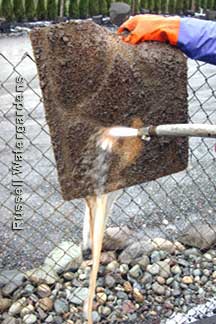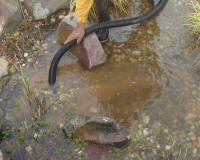Pond Clean Out.com
This website’s purpose is to help take care of the extremes of overwhelmed ponds and/or filters. When a pond is inadequately filtered, a layer of debris will accumulate in it. Old leaves, pine needles, aquatic plant leaves, old flowers, stems, roots, seed pods, you name it, it ends up in the bottom of an inadequately or under-filtered pond.
Even an adequately filtered pond may be inundated by a
mid-fall leaf drop. If removed promptly, no problem. If left alone, by spring
they’ve broken down to little pieces, on their way to being “gunk”.
.
Let’s face it, a lot of ponds are not properly filtered, or don’t have someone getting the extra leaves out of them in the fall. These ponds will require a periodic clean and rinse. No getting around it, if you don’t get rid of this gunk, water quality and fish health, along with human and pet health, will all suffer to varying degrees, based on how long you let it go.
The “once a year” cleaned water fall unit filters currently being widely sold in our industry, are nothing of the kind. All of them should be cleaned much more frequently in the average pond. Once the media in ANY filter becomes clogged with debris (which is it’s job), channeling occurs.
Channeling is easily visible in these filters in as little as a week after they are cleaned. You’ll notice the water coming up in a corner, or along an edge, not welling up evenly through the media, as it should. At this point, the “gunk” they should be catching, goes right back into the pond, where it accumulates until someone cleans it out, or it turns into a cesspool of dead fish, mosquitoes and decaying debris.
Why aren’t we informed of this more frequent cleaning necessity? Good question. Marketing? I’ll leave that to another time, let’s get these nasty ponds cleaned up!
Keep in mind, most of the ponds we’re cleaning the way
I’m about to describe, are totally rock and gravel covered. A bare liner or
concrete pond is easier to get 99.9% clean, than a pond covered with rocks and
gravel. It doesn’t really take that much more time, it’s just in the
methodology, which I’m about to share with you.
First, if fish are present, we need adequate alternate housing for them. A half dozen small goldfish have no problem for a couple hours in a 30 gallon trash can half full of fresh, de-chlorinated water. A pond with larger fish, poses a different situation. Adequate sized tanks, 100-200 gallon capacity should be considered in this format, with additional air supplied by an air stone and small air pump.
AN IMPORTANT POINT:
Cover the tank or tanks with a net or other type of cover
to keep the fish from jumping out. Put the tank or tanks
in the shade if possible, and periodic checking on the fish is a good idea. You may
need to do a partial water change on a tank with large fish after an hour or
two, as the stress of moving them, and the small amount of water in these tanks
can get ammonia saturated fairly quickly.
We normally use 2 pumps in our cleanout regimen. One to drain, and one to “boil” and rinse.

After lowering the pond’s water level enough to safely net out the fish. We use this time and water to rinse the filter mats and media nets, so as not to kill the bacteria that have colonized there, we transfer them with as little trauma and stress as possible to their temporary tanks.
We stop draining temporarily, and commence rinsing and “boiling” the nooks and crannies, as well as any gravel in the pond, with a 4000 gph pump with 1 ½ “ flex pipe on it. This boiling and rinsing could never be done with a garden hose, and a pressure washer blows gravel clear across the pond, as well as stripping the “bio film” off of everything. We use volume of water, not pressure, to clean the pond. We start at the top and work our way down.
 Once we have the upper areas of the pond “boiled” and
rinsed (even with the nasty water, it works!), we start to run new water into
the pond, and start draining again with the other, larger pump. We use a 7000
gph pump with 2” flex pipe to do our draining. We continue to work our way down
the pond until we’re at the bottom. Here, we’ll re-fill with enough fresh water
to do another “quick rinse” of the entire pond, and then boil and rinse the
bottom.
Once we have the upper areas of the pond “boiled” and
rinsed (even with the nasty water, it works!), we start to run new water into
the pond, and start draining again with the other, larger pump. We use a 7000
gph pump with 2” flex pipe to do our draining. We continue to work our way down
the pond until we’re at the bottom. Here, we’ll re-fill with enough fresh water
to do another “quick rinse” of the entire pond, and then boil and rinse the
bottom.
While the pond is empty, or very near empty, is a good time to do thinning and fertilizing of the plants prior to refilling.
We don’t strive for 100% removal of all debris, feeling that 85-95% is adequate. We do, however, strive for 100% rinsing and boiling, even with the dirty water. This does leave some bio-starter, and to achieve the last 10% would take 100% more water and time. Not really economically feasible, and not really necessary in the overall picture of an “ecosystem”.
We normally do these cleanouts “once a year”, to take
care of the “once a year” type filters that are currently in vogue in the water
garden industry. Using this methodology, and based on how much travel time
between ponds, we can clean 2 to 3 , 10X15 ponds in a day. A 15X20 pond with
20-30 large fish may take 3-4 hours.
Catching and transferring fish burns up
time.
We use bulk dry de-chlorinator, and when 6-8” of water is back into the pond, we gently re-introduce the fish. At this point, we were packing everything up except the tank and aerator while the pond was refilling to this point, so we leave the water running for the client to shut off, unless they want to pay us to sit around and wait for it to fill up. The customers are glad to shut the water off and turn on the pump. You just need to let them know in advance, and remind them the day of the clean. With an auto-fill, all that needs to be done by the customer is plug in the pump.
We use 150-200% of the pond’s volume as the basis of our de-chlorinator dosing. Better to be safe than sorry with de-chlorinator. It’s almost impossible to overdose, but easy to under-dose.
Back up and running-for "another year".
I tried to give you the basics of our method, and not get encyclopedic. I feel any experienced hobbyist or contractor should easily be able to duplicate these methods, and the success we’ve had with them. BE SURE TO CHECK OUT RELATED TOPICS!
Copyright 2006 IPPCA